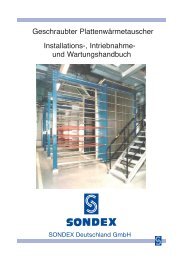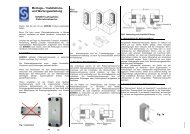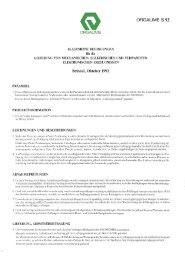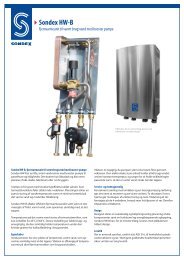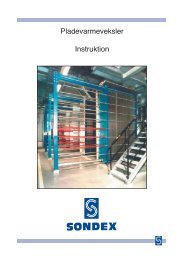"Semi-Welded" Plate Heat Exchanger SW59 - Sondex
"Semi-Welded" Plate Heat Exchanger SW59 - Sondex
"Semi-Welded" Plate Heat Exchanger SW59 - Sondex
You also want an ePaper? Increase the reach of your titles
YUMPU automatically turns print PDFs into web optimized ePapers that Google loves.
"<strong>Semi</strong>-Welded" <strong>Plate</strong> <strong>Heat</strong> <strong>Exchanger</strong> <strong>SW59</strong><br />
Recommended applications:<br />
The “<strong>Semi</strong>-Welded” plate heat exchanger uses<br />
laser welded cassettes which are made up of<br />
two plates welded together using modern laser<br />
welding machines. These cassettes are designed<br />
for the refrigeration industry where<br />
ag gressive products such as ammonia are<br />
used. Applications include cooling, heating and<br />
heat recovery where one product will be<br />
aggressive.<br />
The design pressure is 16 (232PSI) or<br />
25(363PSI) Bar.<br />
Design principles:The “<strong>Semi</strong>-Welded” plate<br />
heat exchanger contains a plate pack in which<br />
the waved “herringbone” pattern is pressed<br />
into each plate.<br />
The products passes through the port holes<br />
and into the gap between the plates.<br />
The product which flows through the cassettes,<br />
is only in contact with the special ring<br />
gaskets located in two of the four port holes.<br />
The opposite product flows through the gap<br />
sealed by plate gaskets preventing any leaks.<br />
er happens when the warmer product transfers<br />
energy through the flow plates and delivers<br />
it to the colder opposing product without<br />
mixing the both products.<br />
The design of the plate and inlet allows for<br />
ef fective and easy CIP (cleaning in place)<br />
clean ing of all surfaces in touch with the products.<br />
The “herringbone” pattern ensures turbulent<br />
flow within the effective area. Furthermore this<br />
pattern brings ”metallic” contact between the<br />
plates, then optimal differential pressure is<br />
achieved.<br />
Duty, type of product, temperatures, pressure<br />
drop and the thermal dynamic properties influence<br />
the choice of type, size of heat surface<br />
and thermal design of the plate pattern.<br />
The plate pack is assembled and pressed<br />
together within the frame containing two strong<br />
endplates, (head and follower), upper- and<br />
lower bars, column and clamping bolts.
<strong>Plate</strong> material:<br />
Standard is AISI 316 and Titanium.<br />
When requested also Hastelloy C 276,<br />
254 SMO or other pressable material.<br />
Gasket material:<br />
<strong>Plate</strong> gaskets are Nitrile, EPDM and<br />
Viton.<br />
Ring gaskets are Nitrile, EPDM,<br />
Chlorprene and Viton.<br />
Techical information:<br />
The painted frame made of St P265GH<br />
(A36, SA516GR70) and standard colour<br />
Blue RAL 5010.<br />
Other colours can be supplied.<br />
The frame is constructed for 16(232PSI)<br />
and 25(363PSI) Bar working pressure.<br />
The clamping bolts are placed around<br />
the edge of the endplates.<br />
Construction standard:<br />
TÜV- Norm A-D ”Merkblätter” B5 and<br />
PED 97/23/EC are followed.<br />
ASME Code can be supplied.<br />
Connections:<br />
DN 200 (8 inches) flanges according to<br />
all known standards.<br />
Cladded with AISI 316 or Titanium.<br />
Accessories:<br />
Screen plate in Stainless Steel.<br />
Foundation feet for the frame.<br />
Spanner / Wrench.<br />
Insulation jacket.<br />
sondex A/s • jernet 9 • dK-6000 Kolding • denmArK<br />
Phone +45 76 30 61 00 • Telefax +45 75 53 89 68 / +45 75 50 50 19



